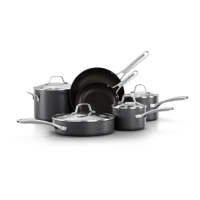
Do you have a question about the Calphalon Classic and is the answer not in the manual?
| Material | Hard-anodized aluminum |
|---|---|
| Dishwasher Safe | Yes |
| Handle Material | Stainless Steel |
| Oven Safe | Yes |
| Non-Stick | Yes |
| Heat Resistance | 450°F |
Wash cookware in warm, sudsy water, rinse, and dry thoroughly before first use.
Safe for use on gas, electric, electric coil, halogen, ceramic, and induction cooktops.
Preheat pan with intended heat setting before adding butter or oil; avoid high heat.
Use medium heat for general cooking, medium-high for searing/frying, high for liquids.
Use the 'butter test' for preheating; use small amounts of oil, heat for one minute.
Do not use aerosol cooking sprays as they damage the non-stick coating and build up.
Oven safe to 450°F; handles can become very hot; not safe for broiler use.
Use caution with handles on stovetop/oven; hot handles can cause burns.
Use plastic, coated, nylon, or wooden utensils to protect the non-stick finish.
Do not use metal utensils or sharp instruments; they damage the finish and void warranty.
Remove food from refrigerator 10 minutes prior to cooking to prevent sticking.
Allow pans to cool completely before washing; avoid immersing hot pans in cold water.
Dishwasher safe, but hand washing is recommended for preserving luster.
Use liquid detergent, a non-abrasive sponge, or soft bristle brush for hand washing.
Do not use abrasive cleaners, oven cleaners, bleach, or caustic solutions.
Use Bar Keeper's Friend or similar polish with a non-abrasive sponge.
